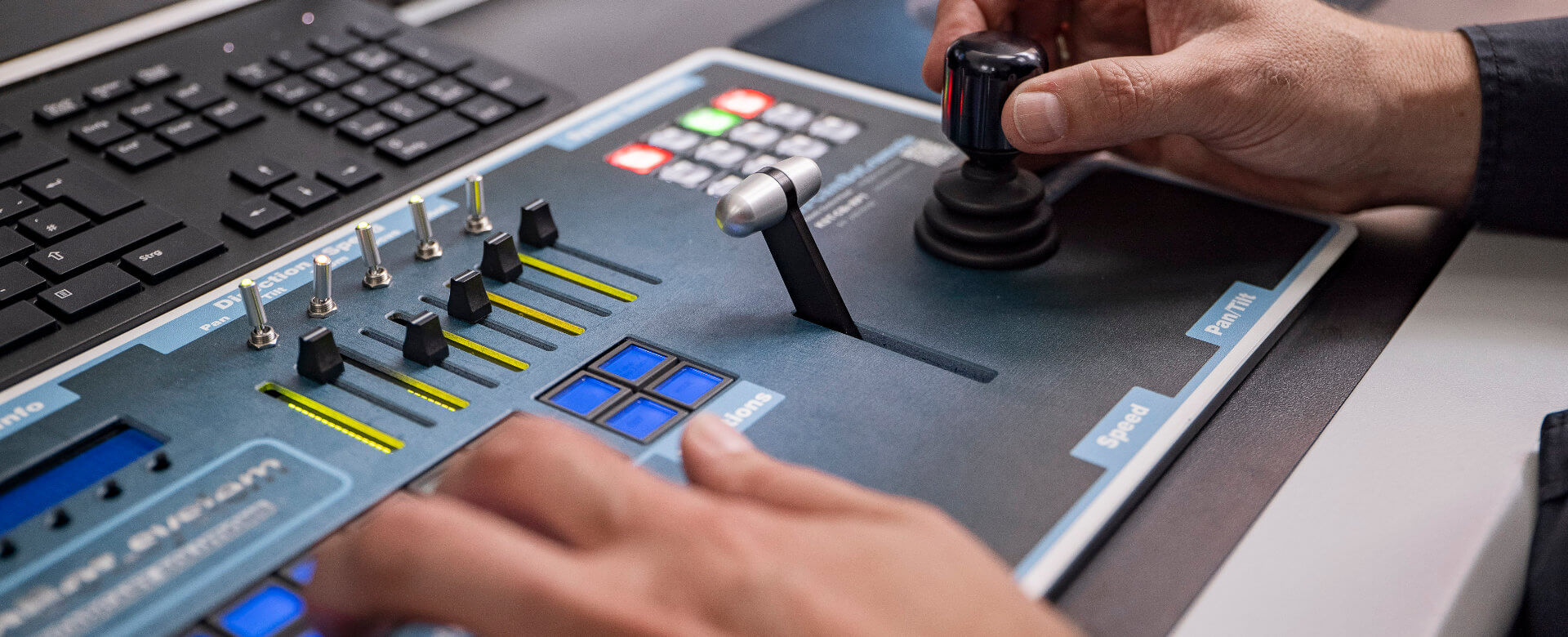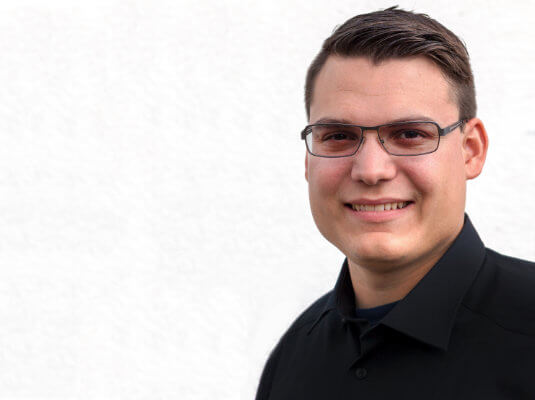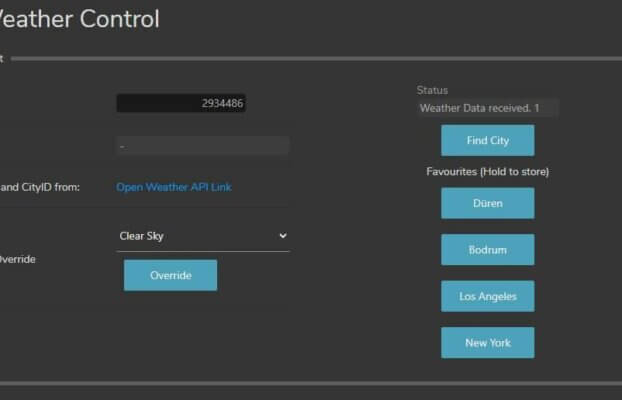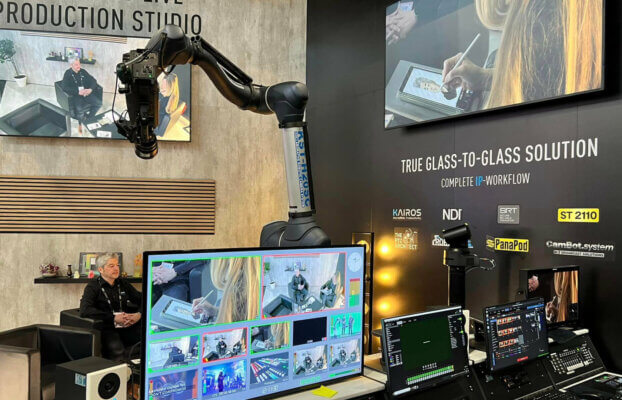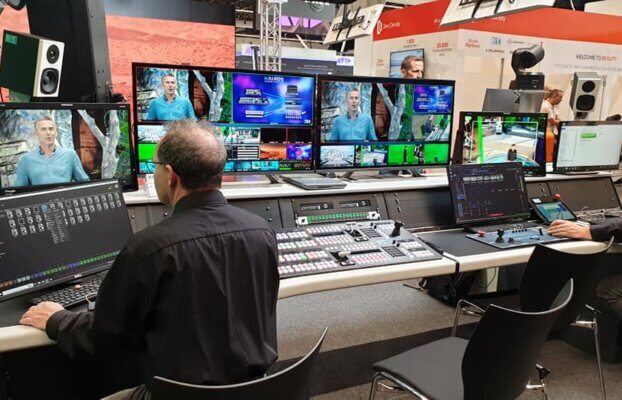Studio automation offers many advantages: Productions can be made more complex with less effort through automated processes and also offer the possibility to programme camera movements in advance, shifting much of the work before the actual production.
The camera operators are relieved by planned processes so that they can concentrate on a clean picture and the ideal creative realisation during the production instead of on the technology.
To further develop the automation of the broadcast workflow, KST has developed its own modular product CamBot®.system developed.
Access to the entire workflow
Automation should not be limited to individual sub-aspects of the workflow, as this would limit synergies. With KST, the entire workflow can therefore be centralized in one system and jointly controlled, linked and scheduled.
Communication on the part of the software at the network level enables control by external devices. In this way, commands can be created which can then be executed by an image mixer (e.g. KAIROS). Dies fördert den Prozess der Automatisierung und bringt ihn auf die nächste Stufe. Suitable preparation reduces the production process to a high degree. In the following video you can see how KAIROS accesses CamBot®.system view.
Modularity
CamBot®.system has a modular design and can therefore be configured individually according to customer requirements and intended use. For example, at the beginning customers can only control the camera with CamBot ® implement and gradually use the system in other areas as well.
Development
The core of the CamBot®.system-software has already been developed and productively used for 20 years by our Munich partner company. The user interface was ideally adapted to the studio operation and the needs of the users, which makes CamBot ® makes it the ideal interface.
The further development of CamBot®.system is carried out dynamically and project-related. Therefore, KST also focuses development on individual and project-specific needs.
Dynamic automation
CamBot® enables dynamic automation. Thus, the system ensures manual interventions in the pre-programmed matrices at any time, so that users can react spontaneously to unexpected situations. For example, camera movements can be lengthened or shortened live during the show, depending on how long the presenter stays at a position, without having to change or overwrite the programming.
User friendly interface
The control software CamBot®.remote PRO offers extensive features, but can additionally be linked to third-party technology such as talent tracking. This allows users to use the full depth of control and programming in an intuitive and transparent way. But also new or inexperienced operators can work with the software at short notice due to its high user-friendliness, regardless of the complexity of the system to be controlled.
New views
The use of a robotic camera system, in addition to automation, repeatability and cleanliness of the runs, also offers possibilities in terms of dynamics within the production, because, depending on the system used, the cameras can be moved freely in space.
Planability
In CamBot® any number of moves and presets can be stored to be played back accurately and repeatedly as often as desired. Depending on the production, it is possible to completely dispense with camera operators with the help of detailed planning. Thanks to the possibilities of the software, it is still possible to intervene creatively - control remains with the operator.
Safety
A moving, robotic camera system, especially in a spatially limited studio environment, normally brings with it a non-negligible risk in the form of possible collisions.
Only collaborative robots, also called cobots, are used for the studios planned by KST. Collaborative robots are designed to work together with humans, for example on assembly lines, so they meet special safety criteria. This includes probably the most important function, the pausing of the movement at a pressure of > 2.5 kg against the robot arm. Therefore, they can work directly with humans without safety zones, allowing professional studio productions to be automated even in small spaces.
Furthermore, there is a precise, graphical live simulation of the controlled systems and the environment on the software side. The software automatically avoids collisions with the environment and the robots used, both during manual operation and during the calculation of trips.
Remote capability
CamBot®.system offers as its core a freely scalable and stackable server system that controls the individual peripheral devices and manages the system. Both the servers among themselves and the clients, which form the operator-side interface with the control software and hardware, are connected via IP. This can be a local connection or a remote connection via the Internet. The system can therefore also be operated decentrally from several locations.
Module overview
CamBot®. systems robot control remote mirror distribution audio switch lightning playout graphic track match
CamBot®.control
CamBot®.control is the freely scalable and stackable server system that forms the core of CamBot®.system. In addition to all performance-heavy processes, such as the calculation of kinematics and collision avoidance, the server architecture also manages the interfaces to the individual internal and external systems. CamBot®.control offers exemplary redundancy capabilities that ensure 24/7 operation without a minute of downtime. The server system can be freely deployed, and the communication between the servers is exclusively IP-based.
CamBot®.robot
- Pan & tilt
- PTZ
- Robot
- Cranes
- Drones
- Spidercams
CamBot®.light
With CamBot®.light, complex lighting systems and sceneries can be integrated into the system and controlled centrally. Depending on the light settings or even the movements of individual effects and spots can be naturally co-controlled by the operator and fully linked to the rest of the overall system.
CamBot®.remote
CamBot®.matching
CamBot®.matching allows the control of all camera-side functions. Hereby the functions of a conventional RCP are taken over by the software and can be stored preset-related and controlled automatically. It is therefore possible, for example, to seamlessly adjust the aperture, white balance or other settings of the camera as a controlled, programmable axis during a camera movement from indoor to outdoor areas.
CamBot®.graphics
With CamBot®.graphics, a feature-rich interface to on-air and VR graphics systems, such as Reality by Zero Density, has been created. Thereby it becomes possible to automate and control all aspects and settings of the graphics from CamBot®. This can be prepared animations of AR objects, the manual control of AR objects themselves or the content on background screens. It is also possible to use pure virtual cameras like real cameras with manual control and programming.
KST Weather Control Module for Zero Density’s RealityHub
21. March 2023The KST development team has recently completed the “KST Weather Control Module”. It is an interface for Zero Density’s RealityHub and can be integrated via API. The weather module automatically loads the current weather of the city selected in the...
ISE 2023 – Complete IP studio within a few days?
7. February 2023Go. KST Moschkau implemented it as a partner of Panasonic for their ISE booth in Barcelona. During the AV trade fair ISE in Barcelona, Panasonic showed the current line-up of Panasonic on this topic with a complete IP studio at...
IBC 2022 – Virtual studio production automation
8. September 2022At the Zero Density booth, KST Moschkau showed the extent to which productions in virtual studios can be automated with Reality, CamBot systems and Kairos. As a partner at the Zero Density booth, the KST CamBot team gave deep insights...
